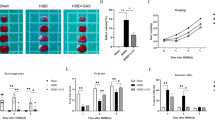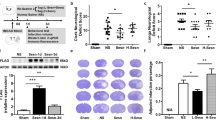Abstract
Cerebral ischemia-reperfusion (I/R) injury is an inflammation-related disease. CHRFAM7A can regulate inflammatory responses. Therefore, the present study investigated the mechanism of CHRFAM7A in cerebral I/R injury. CHRFAM7A expression and inflammatory cytokine levels in patients with cerebral I/R injury and oxygen-glucose deprivation/reperfusion (OGD/R)-treated microglia were detected. The proliferation, inflammatory cytokine expressions, nod-like receptor protein 3 (NLRP3) level, cell pyroptosis, and viability and lactate dehydrogenase (LDH) activity in OGD/R-treated microglia were detected after CHRFAM7A overexpression. The NLRP3/Caspase-1 pathway was activated to assess the effect of CHRFAM7A on microglia. Expressions of microglial M1 phenotype marker iNOS and M2 marker Arg1 were detected. Downregulated CHRFAM7A and elevated inflammatory cytokine levels were observed in patients with cerebral I/R injury and OGD/R-treated microglia. In OGD/R-treated microglia, CHRFAM7A overexpression promoted cell proliferation and viability, reduced inflammation and LDH activity, and inhibited NLRP3 inflammasome activation and cell pyroptosis. Mechanically, CHRFAM7A inhibited microglia pyroptosis via inhibiting the NLRP3/Caspase-1 pathway and reduced cell inflammatory injury via promoting microglia polarization from M1 to M2. Overall, CHRFAM7A overexpression attenuated cerebral I/R injury by inhibiting microglia pyroptosis in a NLRP3/Caspase-1 pathway-dependent manner and promoting microglia polarization to M2 phenotype.






Similar content being viewed by others
Data Availability
All the data generated from this study are included in this manuscript.
References
Jung, G.B., S.W. Kang, G.J. Lee, and D. Kim. 2018. Biochemical characterization of the brain hippocampal areas after cerebral ischemia-reperfusion using Raman spectroscopy. Appl Spectrosc 72 (10): 1479–1486.
He, F., R. Dai, X. Zhou, X. Li, X. Song, H. Yan, Q. Meng, C. Yang, and Q. Lin. 2019. Protective effect of 4-Methoxy benzyl alcohol on the neurovascular unit after cerebral ischemia reperfusion injury. Biomed Pharmacother 118: 109260.
Yang, J., M. Chen, R.Y. Cao, Q. Li, and F. Zhu. 2018. The role of circular RNAs in cerebral ischemic diseases: ischemic stroke and cerebral ischemia/reperfusion injury. Adv Exp Med Biol 1087: 309–325.
Xie, W., P. Zhou, Y. Sun, X. Meng, Z. Dai, G. Sun, and X. Sun. 2018. Protective effects and target network analysis of ginsenoside Rg1 in cerebral ischemia and reperfusion injury: a comprehensive overview of experimental studies. Cells 7 (12).
Leech, T., N. Chattipakorn, and S.C. Chattipakorn. 2019. The beneficial roles of metformin on the brain with cerebral ischaemia/reperfusion injury. Pharmacol Res 146: 104261.
Hassonizadeh Falahieh, K., A. Sarkaki, M. Edalatmanesh, M.K. Gharib Naseri, and Y. Farbood. 2020. Ellagic acid attenuates post-cerebral ischemia and reperfusion behavioral deficits by decreasing brain tissue inflammation in rats. Iran J Basic Med Sci 23 (5): 645–653.
Guo, Z., S. Yu, X. Chen, R. Ye, W. Zhu, and X. Liu. 2016. NLRP3 is involved in ischemia/reperfusion injury. CNS Neurol Disord Drug Targets 15 (6): 699–712.
Zhu, S., Z. Zhang, L.Q. Jia, K.X. Zhan, L.J. Wang, N. Song, Y. Liu, Y.Y. Cheng, Y.J. Yang, L. Guan, D.Y. Min, and G.L. Yang. 2019. Valproic acid attenuates global cerebral ischemia/reperfusion injury in gerbils via anti-pyroptosis pathways. Neurochem Int 124: 141–151.
Zhang, D., J. Qian, P. Zhang, H. Li, H. Shen, X. Li, and G. Chen. 2019. Gasdermin D serves as a key executioner of pyroptosis in experimental cerebral ischemia and reperfusion model both in vivo and in vitro. J Neurosci Res 97 (6): 645–660.
Voet, S., M. Prinz, and G. van Loo. 2019. Microglia in central nervous system inflammation and multiple sclerosis pathology. Trends Mol Med 25 (2): 112–123.
Tang, Y., and W. Le. 2016. Differential roles of M1 and M2 microglia in neurodegenerative diseases. Mol Neurobiol 53 (2): 1181–1194.
Zhao, X.P., Y. Zhao, X.Y. Qin, L.Y. Wan, and X.X. Fan. 2019. Non-invasive vagus nerve stimulation protects against cerebral ischemia/reperfusion injury and promotes microglial M2 polarization via interleukin-17A inhibition. J Mol Neurosci 67 (2): 217–226.
Sun, P., L. Li, C. Zhao, M. Pan, Z. Qian, and X. Su. 2017. Deficiency of alpha7 nicotinic acetylcholine receptor attenuates bleomycin-induced lung fibrosis in mice. Mol Med 23: 34–39.
Costantini, T.W., T.W. Chan, O. Cohen, S. Langness, S. Treadwell, E. Williams, B.P. Eliceiri, and A. Baird. 2019. Uniquely human CHRFAM7A gene increases the hematopoietic stem cell reservoir in mice and amplifies their inflammatory response. Proc Natl Acad Sci U S A 116 (16): 7932–7940.
de Lucas-Cerrillo, A.M., M.C. Maldifassi, F. Arnalich, J. Renart, G. Atienza, R. Serantes, J. Cruces, A. Sanchez-Pacheco, E. Andres-Mateos, and C. Montiel. 2011. Function of partially duplicated human alpha77 nicotinic receptor subunit CHRFAM7A gene: potential implications for the cholinergic anti-inflammatory response. J Biol Chem 286 (1): 594–606.
Araud, T., S. Graw, R. Berger, M. Lee, E. Neveu, D. Bertrand, and S. Leonard. 2011. The chimeric gene CHRFAM7A, a partial duplication of the CHRNA7 gene, is a dominant negative regulator of alpha7*nAChR function. Biochem Pharmacol 82 (8): 904–914.
Zhang, Y., J. Qian, H. Ren, F. Meng, R. Ma, and B. Xu. 2017. Human-specific CHRFAM7A protects against radiotherapy-induced lacrimal gland injury by inhibiting the p38/JNK signalling pathway and oxidative stress. Int J Clin Exp Pathol 10 (8): 9001–9011.
Costantini, T.W., X. Dang, R. Coimbra, B.P. Eliceiri, and A. Baird. 2015. CHRFAM7A, a human-specific and partially duplicated alpha7-nicotinic acetylcholine receptor gene with the potential to specify a human-specific inflammatory response to injury. J Leukoc Biol 97 (2): 247–257.
Morioka, N., K. Hisaoka-Nakashima, and Y. Nakata. 2018. Regulation by nicotinic acetylcholine receptors of microglial glutamate transporters: role of microglia in neuroprotection. In Nicotinic Acetylcholine Receptor Signaling in Neuroprotection, eds. A. Akaike, and S. Shimohama, and Y. Misu, 73-88. Singapore.
Li, X., Z. Huang, S. Liu, X. Zeng, J. Xie, C. Liu, H. Xiao, R. Liu, L. Li, and J. Zeng. 2018. 3'-Daidzein sulfonate sodium provides neuroprotection by promoting the expression of the alpha7 nicotinic acetylcholine receptor and suppressing inflammatory responses in a rat model of focal cerebral ischemia. Am J Transl Res 10 (11): 3455–3464.
Li, J., Q. Zhang, S. Li, L. Niu, J. Ma, L. Wen, L. Zhang, and C. Li. 2020. alpha7nAchR mediates transcutaneous auricular vagus nerve stimulation-induced neuroprotection in a rat model of ischemic stroke by enhancing axonal plasticity. Neurosci Lett 730: 135031.
Luan, J., X. Zhang, S. Wang, Y. Li, J. Fan, W. Chen, W. Zai, S. Wang, Y. Wang, M. Chen, G. Meng, and D. Ju. 2018. NOD-like receptor protein 3 inflammasome-dependent IL-1beta accelerated ConA-induced hepatitis. Front Immunol 9: 758.
Jiang, Y., H. Yuan, L. Huang, X. Hou, R. Zhou, and X. Dang. 2019. Global proteomic profiling of the uniquely human CHRFAM7A gene in transgenic mouse brain. Gene 714: 143996.
Courties, A., A. Do, S. Leite, M. Legris et al. 2020. The role of the non-neuronal cholinergic system in inflammation and degradation processes in osteoarthritis. Arthritis Rheumatol.
Li, J., H. Zhang, and C. Zhang. 2012. Role of inflammation in the regulation of coronary blood flow in ischemia and reperfusion: mechanisms and therapeutic implications. J Mol Cell Cardiol 52 (4): 865–872.
Dang, D.D., H. Saiyin, Q. Yu, and W.M. Liang. 2018. Effects of sevoflurane preconditioning on microglia/macrophage dynamics and phagocytosis profile against cerebral ischemia in rats. CNS Neurosci Ther 24 (6): 564–571.
Eldahshan, W., S.C. Fagan, and A. Ergul. 2019. Inflammation within the neurovascular unit: focus on microglia for stroke injury and recovery. Pharmacol Res 147: 104349.
Ye, X., T. Shen, J. Hu, L. Zhang, Y. Zhang, L. Bao, C. Cui, G. Jin, K. Zan, Z. Zhang, X. Yang, H. Shi, J. Zu, M. Yu, C. Song, Y. Wang, S. Qi, and G. Cui. 2017. Purinergic 2X7 receptor/NLRP3 pathway triggers neuronal apoptosis after ischemic stroke in the mouse. Exp Neurol 292: 46–55.
Broz, P., and V.M. Dixit. 2016. Inflammasomes: mechanism of assembly, regulation and signalling. Nat Rev Immunol 16 (7): 407–420.
Chang, H., H. Chang, T. Cheng, D. Li, X. Chen, and K. Qi. 2020. microRNA-23a-3p prevents the onset of type 2 diabetes mellitus by suppressing the activation of NLRP3 inflammatory bodies-caused pyroptosis through negatively regulating NEK7. J Diabetes Investig.
Lee, S.W., J.P. de Rivero Vaccari, J.S. Truettner, W.D. Dietrich, and R.W. Keane. 2019. The role of microglial inflammasome activation in pyroptotic cell death following penetrating traumatic brain injury. J Neuroinflammation 16 (1): 27.
Zhou, L., D. Wang, X. Qiu, W. Zhang, Z. Gong, Y. Wang, and X. Xu. 2020. DHZCP modulates microglial M1/M2 polarization via the p38 and TLR4/NF-kappaB signaling pathways in LPS-stimulated microglial cells. Front Pharmacol 11: 1126.
Fukuta, T., T. Ishii, T. Asai, and N. Oku. 2019. Applications of liposomal drug delivery systems to develop neuroprotective agents for the treatment of ischemic stroke. Biol Pharm Bull 42 (3): 319–326.
He, Z., C. Ma, T. Yu, J. Song, J. Leng, X. Gu, and J. Li. 2019. Activation mechanisms and multifaceted effects of mast cells in ischemia reperfusion injury. Exp Cell Res 376 (2): 227–235.
Matsumura, A., S. Suzuki, N. Iwahara, S. Hisahara, J. Kawamata, H. Suzuki, A. Yamauchi, K. Takata, Y. Kitamura, and S. Shimohama. 2015. Temporal changes of CD68 and alpha7 nicotinic acetylcholine receptor expression in microglia in Alzheimer’s disease-like mouse models. J Alzheimers Dis 44 (2): 409–423.
Alzarea, S., and S. Rahman. 2018. Effects of alpha-7 nicotinic allosteric modulator PNU 120596 on depressive-like behavior after lipopolysaccharide administration in mice. Prog Neuropsychopharmacol Biol Psychiatry 86: 218–228.
Minutoli, L., D. Puzzolo, M. Rinaldi, N. Irrera, et al. 2016. ROS-mediated NLRP3 inflammasome activation in brain, heart, kidney, and testis ischemia/reperfusion injury. Oxid Med Cell Longev 2016: 2183026.
Jiang, T., M. Wu, Z. Zhang, C. Yan, Z. Ma, S. He, W. Yuan, K. Pu, and Q. Wang. 2019. Electroacupuncture attenuated cerebral ischemic injury and neuroinflammation through alpha7nAChR-mediated inhibition of NLRP3 inflammasome in stroke rats. Mol Med 25 (1): 22.
Zhou, J., M. Wang, and D. Deng. 2020. KLF2 protects BV2 microglial cells against oxygen and glucose deprivation injury by modulating BDNF/TrkB pathway. Gene 735: 144277.
Ke, P., B.Z. Shao, Z.Q. Xu, X.W. Chen, W. Wei, and C. Liu. 2017. Activating alpha7 nicotinic acetylcholine receptor inhibits NLRP3 inflammasome through regulation of beta-arrestin-1. CNS Neurosci Ther 23 (11): 875–884.
Kalmady, S.V., R. Agrawal, D. Venugopal, V. Shivakumar, A.C. Amaresha, S.M. Agarwal, M. Subbanna, A. Rajasekaran, J.C. Narayanaswamy, M. Debnath, and G. Venkatasubramanian. 2018. CHRFAM7A gene expression in schizophrenia: clinical correlates and the effect of antipsychotic treatment. J Neural Transm (Vienna) 125 (4): 741–748.
Chan, T.W., S. Langness, O. Cohen, B.P. Eliceiri, A. Baird, and T.W. Costantini. 2020. CHRFAM7A reduces monocyte/macrophage migration and colony formation in vitro. Inflamm Res 69 (7): 631–633.
Wang, Q.S., X.Y. Luo, H. Fu, Q. Luo, M.Q. Wang, and D.Y. Zou. 2020. MiR-139 protects against oxygen-glucose deprivation/reoxygenation (OGD/R)-induced nerve injury through targeting c-Jun to inhibit NLRP3 inflammasome activation. J Stroke Cerebrovasc Dis 29 (9): 105037.
Aryanpour, R., P. Pasbakhsh, K. Zibara, Z. Namjoo, F. Beigi Boroujeni, S. Shahbeigi, I.R. Kashani, C. Beyer, and A. Zendehdel. 2017. Progesterone therapy induces an M1 to M2 switch in microglia phenotype and suppresses NLRP3 inflammasome in a cuprizone-induced demyelination mouse model. Int Immunopharmacol 51: 131–139.
Boddaert, J., K. Bielen, B.S. Jongers, E. Manocha, L. Yperzeele, P. Cras, D. Pirici, and S. Kumar-Singh. 2018. CD8 signaling in microglia/macrophage M1 polarization in a rat model of cerebral ischemia. PLoS One 13 (1): e0186937.
Zhang, Q., Y. Lu, H. Bian, L. Guo, and H. Zhu. 2017. Activation of the alpha7 nicotinic receptor promotes lipopolysaccharide-induced conversion of M1 microglia to M2. Am J Transl Res 9 (3): 971–985.
Author information
Authors and Affiliations
Contributions
Conceptualization: XC. Validation, research, resources, data reviewing, and writing: XC and YW. Review and editing: LG. All authors read and approved the final manuscript.
Corresponding author
Ethics declarations
Competing interests
The authors declare that they have no conflict of interest.
Ethics approval and consent to participate
This study was performed with the approval of the Clinical Ethical Committee of Shanghai Tenth People’s Hospital. All study subjects signed written informed consents. All procedures were strictly conducted in accordance with the code of ethics.
Consent for publication
Not applicable.
Additional information
Publisher’s Note
Springer Nature remains neutral with regard to jurisdictional claims in published maps and institutional affiliations.
Rights and permissions
About this article
Cite this article
Cao, X., Wang, Y. & Gao, L. CHRFAM7A Overexpression Attenuates Cerebral Ischemia-Reperfusion Injury via Inhibiting Microglia Pyroptosis Mediated by the NLRP3/Caspase-1 pathway. Inflammation 44, 1023–1034 (2021). https://doi.org/10.1007/s10753-020-01398-4
Received:
Revised:
Accepted:
Published:
Issue Date:
DOI: https://doi.org/10.1007/s10753-020-01398-4




